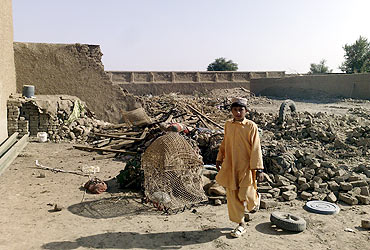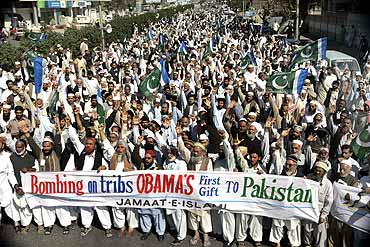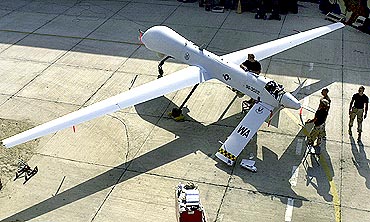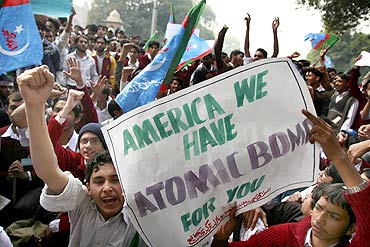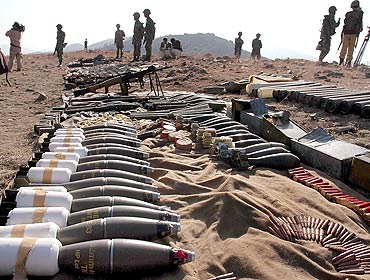 | « Back to article | Print this article |
US drone attacks in Pak hit a century this year
American drone attacks in Pakistan hit a century in 2010, when United States missiles hit a vehicle carrying four terrorists near the Afghan border early on Tuesday. The 100th attack of the year occurred in the Bangi Dar village in North Waziristan, reports Tahir Ali.
Drone attacks have become a daily affair in North Waziristan, the hub of local and foreign terrorists in Pakistan. The Americans want Pakistanis to launch a military assault against these terrorists but Islamabad is reluctant to do so -- as a result the US has increased drone attacks in this area.
Since US President Barack Obama came into office, there have been 158 drone attacks, with 58 strikes in 2009 and 100 so far in 2010. There have been a total of 213 drone strikes in Pakistan's federally- administered tribal areas since the series of attacks was launched in June 2004 in South Waziristan.The first ever attack killed Taliban commander Naik Muhammad Wazir, who was among the first to target the US forces in Afghanistan.
Air strikes are counterproductive: Pak
So far about 2,100 people have been killed and more than 500 have sustained injuries in these drone strikes -- the targetted people include 36 high-profile terrorists but at the same time many women and children have been the victims of such attacks too.
The drone attacks have created a sense of insecurity among tribesmen in the tribal areas and created a siege mentality amongst the locals. The attacks have also resulted in the anger among the common Pashtuns.
At an early stage the Pakistani government condemned such attacks. In early 2009, Pakistan Prime Minister Yusuf Raza Gilani was quoted as saying, "The US drone attacks contribute towards nullifying Pakistani efforts to create a wedge between the loyal tribes and militants besides casting a negative impact on plans to bring peace in the border region; the government did not permit the drone attacks in FATA; there is no agreement with the US in this regard."
Drones strike Taliban, Al Qaeda
For a long time, just like Gilani, other officials also condemned the drone attacks and termed them a threat to Pakistan's sovereignty, but they were silenced when some reports leaked that former US president George W Bush signed an internal security memo authorising important operational changes to the US forces in Afghanistan.
Another factor that silences Pakistan is the list of the high-ranking Taliban and Al Qaeda members being killed during these attacks.
High-profile terrorists fall prey to missiles
On January 1, 2010, the first attack of the year took away Haji Omer, once the head of all Taliban factions in South Waziristan. In the same month, Mansur Al-Shami, an Al Qaeda ideologue and Jamal Saeed Abdul Rahim, the operative of Abu Nidal who participated in the killing 22 hostages during the 1986 hijacking of PanAm flight 73, were also killed during a drone attack.
In February, Abdul Haq Al Turkistani, a member of Al Qaeda's Shura Majlis and the leader of the Eastern Turkistan Islamic Party, Sheikh Mansoor, Al Qaeda Shadow Army commander based in North Waziristan, Mohammed Haqqani, the son of Jalaluddin Haqqani and Qari Mohammad Zafar, the head of Lashkar-i-Jhangvi wanted by the US for attacking the US consulate in Karachi in 2006 were killed during different attacks.
In March, Sadam Hussein Al Hussami, also known as Ghazwan Al Yemeni, was killed during a drone strike. He was a senior operative of the Al Qaeda's external operation network and was said to be involved in the killing of seven Central Intelligence Agency officials in Khost.
Drone wars claim Al Qaeda's No 3
In May, the drones struck a high value target when Mustafa Abu Yazid, also known as Sheikh Saeed al Masri, the Al Qaeda's leader in Afghanistan and top financial functionary was killed in North Waziristan.
On September 25, Sheikh Fateh Al-Masri, Al Qaeda's leader in Afghanistan and Pakistan was reported killed in a US drone attack in North Waziristan. In October, eight German militants were killed during a drone attack in North Waziristan.
